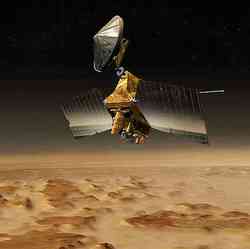
Artist’s concept of Mars Reconnaissance Orbiter. Image credit: NASA/JPL. Click to enlarge
NASA’s next mission to Mars will examine the red planet in unprecedented detail from low orbit and provide more data about the intriguing planet than all previous missions combined. The Mars Reconnaissance Orbiter and its launch vehicle are nearing final stages of preparation at NASA’s Kennedy Space Center, Fla., for a launch opportunity that begins Aug. 10.
The spacecraft will examine Martian features ranging from the top of the atmosphere to underground layering. Researchers will use it to study the history and distribution of Martian water. It will also support future Mars missions by characterizing landing sites and providing a high-data-rate communications relay.
“Mars Reconnaissance Orbiter is the next step in our ambitious exploration of Mars,” said NASA’s director, Mars Exploration Program, Science Mission Directorate, Douglas McCuistion. “We expect to use this spacecraft’s eyes in the sky in coming years as our primary tools to identify and evaluate the best places for future missions to land.”
The spacecraft carries six instruments for probing the atmosphere, surface and subsurface to characterize the planet and how it changed over time. One of the science payload’s three cameras will be the largest-diameter telescopic camera ever sent to another planet. It will reveal rocks and layers as small as the width of an office desk. Another camera will expand the present area of high-resolution coverage by a factor of 10. A third will provide global maps of Martian weather.
The other three instruments are a spectrometer for identifying water-related minerals in patches as small as a baseball infield; a ground-penetrating radar, supplied by the Italian Space Agency, to peer beneath the surface for layers or rock, ice and, if present, water; and a radiometer to monitor atmospheric dust, water vapor and temperature.
Two additional scientific investigations will analyze the motion of the spacecraft in orbit to study the structure of the upper atmosphere and the Martian gravity field.
“We will keep pursuing a follow-the-water strategy with Mars Reconnaissance Orbiter,” said Dr. Michael Meyer, Mars exploration chief scientist at NASA Headquarters. “Dramatic discoveries by Mars Global Surveyor, Mars Odyssey and the Mars Exploration Rovers about recent gullies, near-surface permafrost and ancient surface water have given us a new Mars in the past few years. Learning more about what has happened to the water will focus searches for possible Martian life, past or present.”
Dr. Richard Zurek of NASA’s Jet Propulsion Laboratory, Pasadena, Calif., project scientist for the orbiter, said, “Higher resolution is a major driver for this mission. Every time we look with increased resolution, Mars has said, ‘Here’s something you didn’t expect. You don’t understand me yet.’ We’re sure to find surprises.”
The orbiter will reach Mars in March 2006. It will gradually adjust the shape of its orbit by aerobraking, a technique that uses the friction of careful dips into the planet’s upper atmosphere. For the mission’s 25-month primary science phase, beginning in November 2006, the planned orbit averages about 190 miles above the surface, more than 20 percent lower than the average for any of the three current Mars orbiters. The lower orbit adds to the ability to see Mars as it has never been seen before.
To get information from its instruments to Earth, the orbiter carries the biggest antenna ever sent to Mars and a transmitter powered by large solar panels. “It can send 10 times as much data per minute as any previous Mars spacecraft,” said JPL’s James Graf, project manager. “This increased return multiplies the value of the instruments by permitting increased coverage of the surface at higher resolution than ever before. The same telecommunications gear will be used to relay critical science data to Earth from landers.”
To loft so big a spacecraft, weighing more than two tons fully fueled, NASA will use a powerful Atlas V launch vehicle for the first time on an interplanetary mission.
The mission is managed by JPL, a division of the California Institute of Technology, Pasadena, for the NASA Science Mission Directorate. Lockheed Martin Space Systems, Denver, is the prime contractor for the project and built the spacecraft.
For information about Mars Reconnaissance Orbiter on the Web, visit http://www.nasa.gov/mro
Original Source: NASA News Release
